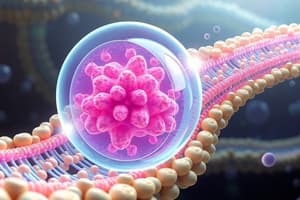Podcast
Questions and Answers
Which form of passive transport involves the movement of water molecules across a selectively permeable membrane?
Which form of passive transport involves the movement of water molecules across a selectively permeable membrane?
- Filtration
- Facilitated diffusion
- Osmosis (correct)
- Simple diffusion
What is the primary driving force for passive transport?
What is the primary driving force for passive transport?
- Concentration gradient (correct)
- Chemical energy
- Mechanical energy
- Electrical energy
Which type of transport requires no energy input?
Which type of transport requires no energy input?
- Filtration
- Simple diffusion (correct)
- Active transport
- Facilitated diffusion
What is the analogy used to explain passive transport in the text?
What is the analogy used to explain passive transport in the text?
In the context of passive transport, what is the opposite of active transport?
In the context of passive transport, what is the opposite of active transport?
What is passive transport also known as?
What is passive transport also known as?
In passive transport, how does an ion or molecule pass through a cell wall?
In passive transport, how does an ion or molecule pass through a cell wall?
Which form of passive transport involves an ion or molecule passing through a cell wall without the assistance of a transport protein?
Which form of passive transport involves an ion or molecule passing through a cell wall without the assistance of a transport protein?
How does active transport differ from passive transport?
How does active transport differ from passive transport?
What analogy is used to describe passive transport in the text?
What analogy is used to describe passive transport in the text?
Flashcards
Osmosis
Osmosis
The movement of water molecules across a selectively permeable membrane from a region of high water concentration to a region of low water concentration.
Concentration gradient
Concentration gradient
The difference in concentration of a substance across a membrane. It drives the movement of substances from a high concentration area to a low concentration area.
Simple diffusion
Simple diffusion
The movement of molecules across a membrane from an area of high concentration to an area of low concentration, without requiring energy.
Passive transport
Passive transport
Signup and view all the flashcards
Active transport
Active transport
Signup and view all the flashcards
Passive diffusion
Passive diffusion
Signup and view all the flashcards
Simple diffusion
Simple diffusion
Signup and view all the flashcards
Difference between passive and active transport
Difference between passive and active transport
Signup and view all the flashcards
Passive transport
Passive transport
Signup and view all the flashcards
Passive transport
Passive transport
Signup and view all the flashcards
Study Notes
Passive Transport
- Osmosis is the form of passive transport that involves the movement of water molecules across a selectively permeable membrane.
- The primary driving force for passive transport is a concentration gradient, where molecules move from an area of high concentration to an area of low concentration.
- Passive transport requires no energy input, as it uses the kinetic energy of molecules to move them across the membrane.
Analogy and Context
- The analogy used to explain passive transport is the diffusion of people into a less crowded area.
- Passive transport is the opposite of active transport, where energy is required to move molecules across the membrane.
- Passive transport is also known as diffusion.
Mechanisms of Passive Transport
- In passive transport, an ion or molecule passes through a cell wall by moving through the lipid bilayer or through a transport protein.
- Facilitated diffusion is the form of passive transport that involves an ion or molecule passing through a cell wall with the assistance of a transport protein.
- Simple diffusion is the form of passive transport that involves an ion or molecule passing through a cell wall without the assistance of a transport protein.
Comparison to Active Transport
- Active transport differs from passive transport in that it requires energy input to move molecules across the membrane, often against a concentration gradient.
- The analogy used to describe passive transport is the diffusion of people into a less crowded area, whereas active transport is like going up a staircase.
Studying That Suits You
Use AI to generate personalized quizzes and flashcards to suit your learning preferences.





